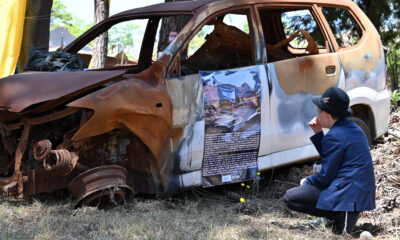
Israel

From blitzkrieg to sitzkrieg – Israel’s combat quandary
Israel is heading towards day 60 of its protracted war in Gaza. Realpolitik temporarily halted the relentless ground and air campaign, which allowed for a trickle of released hostages Hamas has held since 7 October. Sustaining the pause in operations was never going to lead to a permanent ceasefire but was dependent on Hamas releasing hostages daily. The chances of a permanent ceasefire are remote, but one can anticipate further temporary ceasefires as a hard-pressed Hamas seeks a respite from the relentless Israeli attacks. Hostilities will always resume with a vengeance when either Hamas runs out of hostages, or Israel runs out of patience. Both sides used the opportunity of the break in fighting to regroup, rearm, and prepare for the next grinding phase of urban warfare. For now, the sounds of gunfire once again reverberate through the length and breadth of Gaza.
At the strategic level of war, Hamas has a simple game plan. Yahya Sinwar intends to widen the war to encourage an uprising in the West Bank and the inclusion of Hezbollah in a full-blown conflict in northern Israel. There are signs that Hamas is gaining ground at the expense of the Palestinian Liberation Organization in the West Bank, and troubling indications of unrest are occurring daily. An ever-wily Hamas is also seeking to sway Arab-Israelis to support the cause of the ultimate destruction of Israel. International support for Israel, mainly from the West and the United States, has inevitably begun to erode. As the civilian death toll in Gaza rises, Hamas is doing its best to win the propaganda war. Israel, with no clearly defined strategic goal other than the freeing of the remaining hostages and the elimination of Hamas, is steadily losing the propaganda war. What’s urgently needed is a bold Israeli plan for Gaza showing the possibilities after the removal of Hamas and thereafter, an accommodation that will satisfy the political aspirations of the Palestinians.
Of all the armies in the world, the Israel Defense Forces (IDF) is the least suited to conduct a protracted urban campaign. The IDF has a manoeuvre way of warfare – blitzkrieg – which calls for short, sharp, decisive engagements that involve the minimum casualties possible. It will struggle with the massive commitment to boots on the ground and the slow, grinding, attritional warfare demanded in routing out Hamas from its alleyways and tunnels – sitzkrieg. Thus far, contrary to its manoeuvre doctrine, it seems that the IDF has been remarkably successful in surrounding Gaza City and occupying large swathes of northern Gaza, with relatively few casualties. The IDF has indeed demonstrated early signs that it’s willing to conquer and occupy Gaza and commit to the long haul – sitzfleisch.
However, worrying signs are beginning to emerge around the unsuitability of the IDF for the task ahead, as much of the heavy urban fighting is yet to come. Major General Yitzhak Brick sounded the alarm bells in May 2022, when he cautioned, “We lost the inter-arm combat capability and became a one-dimensional air force army that alone could not win a war.” Israel, as in 1973, has become over-dependent on the air force instead of investing in an all-arms combined force, which is essential, especially in urban warfare. Brick identifies Israel’s greater desire for casualty avoidance and over-reliance on technology as factors severely impacting its fighting spirit.
There also seemed to be a lack of a discernible plan to invade Gaza immediately in the wake of the 7 October Hamas atrocities. The IDF had to take time out to plan the operation into Gaza and train its members in urban combat. Delays cost the IDF many valuable days of operational time when Israel still enjoyed the overwhelming moral high ground with Western nations. Many weeks passed before the ground war began on 27 October 2023, and by then, Hamas had gained ascendency in the propaganda war.
In spite of all the reservations surrounding the inevitable casualties that the IDF will suffer in routing out Hamas from its tunnels and urban warrens, the top brass of the IDF seems determined to eliminate its presence from Gaza. The question is, have the Israeli senior and other officers created the proper environment for the ordinary soldier to have a decent chance of completing their task successfully? Does the ordinary IDF soldier fully understand the purpose and importance of the mission ahead? These aren’t easy questions to answer in a battleground shrouded in the fog of war, with the daily news short on details and long on speculation. The IDF, especially its ground forces, is well-equipped for ground warfare. The deployment of heavily armoured Merkava tanks and equally well-protected armour personnel carriers fighting in unison with debussed infantry and tactical airstrikes signals adherence to the principles of combined arms warfare.
Another question is whether Israel will be able to continue to fight the war with the operational style devised with good effect in the past few weeks. There’s mounting pressure from the United States for the Israelis to curb civilian collateral damage. The curtailment of airstrikes and the granting of ceasefires will inevitably lead to more significant IDF casualties. With the Egyptian border crossing at Rafah closed to Gaza refugees seeking to escape the carnage, the IDF will have a near-impossible task of eliminating Hamas in the south among a swollen civilian population of 1.5 million. Unless civilians are allowed to escape to Egypt or given access to safe havens, the second stage of the war is going to witness an intolerable number of civilian casualties. Israel still faces the prospect of a wider war involving Hezbollah and the growing unease in the West Bank. In the face of these increasing challenges, the coming weeks and months will test the IDF’s endurance to the limit.
- Dr David Brock Katz is a research fellow at Stellenbosch University in the faculty of military science. He has published three books and numerous academic articles dealing with aspects of South African military history and military doctrine.











Peter Bernstein
December 8, 2023 at 9:03 am
Excellent insightful article